engine Oldsmobile Achieva 1995 s User Guide
[x] Cancel search | Manufacturer: OLDSMOBILE, Model Year: 1995, Model line: Achieva, Model: Oldsmobile Achieva 1995Pages: 340, PDF Size: 16.99 MB
Page 80 of 340
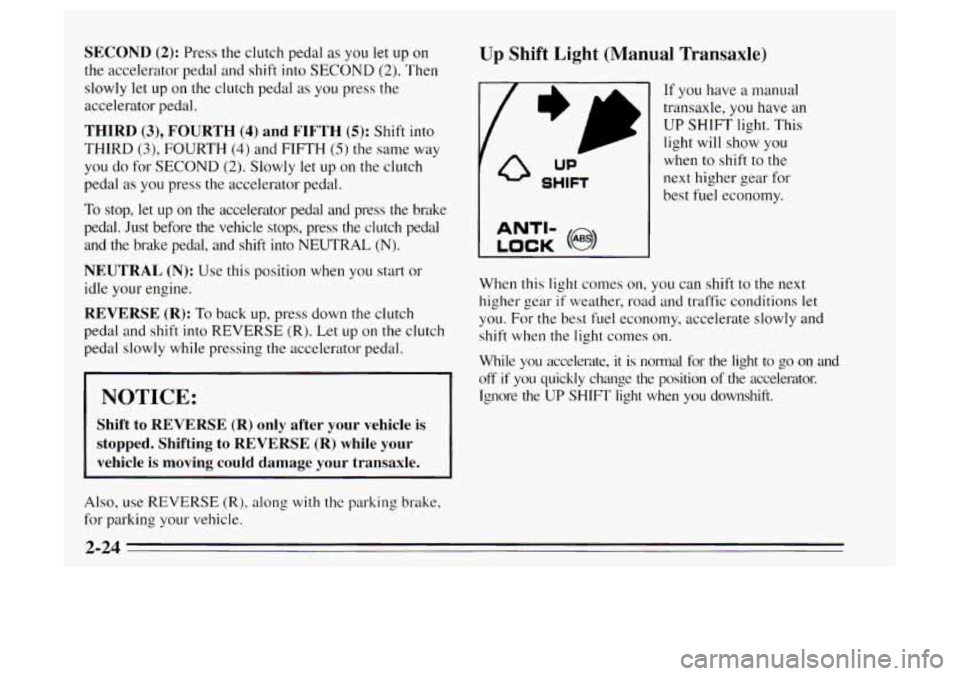
SECOND (2): Press the clutch pedal as you let up 011
the accelerator pedal and shift into SECOND (2). Then
slowly let
up on the clutch pedal as you press the
accelerator pedal.
THIRD (3), FOURTH (4) and FIFTH (5): Shift into
THIRD (3), FOURTH (4) and FIFTH (5) the same way
you do for SECOND (2). Slowly let up on the clutch
pedal as you press the accelerator pedal.
To stop, let up on the accelerator pedal and press the brake
pedal. Just before the vehicle stops, press the clutch pedal
and the brake pedal, and shift into NEUTRAL (N).
NEUTRAL (N): Use this position when you start or
idle your engine.
REVERSE (R): To back up, press down the clutch
pedal and shift into REVERSE
(R). Let up on the clutch
pedal slowly while pressing the accelerator pedal.
NOTICE:
Shift to REVERSE (R) only after your vehicle is
stopped. Shifting to REVERSE (R) while your
vehicle
is moving could damage your transaxle.
Also, use REVERSE (Rj, along with the parking brake,
for parking your vehicle.
Up Shift Light (Manual Transaxle)
If you have a manual
transaxle, you have an
UP
SHIFT light. This
light
will show you
when
to shift to the
next higher gear for
best fuel economy.
When this light comes on, you can shift to the next
higher gear
if weather, road and traffic conditions let
you. For the best fuel economy, accelerate slowly and
shift when the light comes on.
While you accelerate,
it is normal for the light to go on and
off if you quickly change the position of the accelerator.
Ignore the UP SHIFT light when
you downshift.
2-24
Page 81 of 340
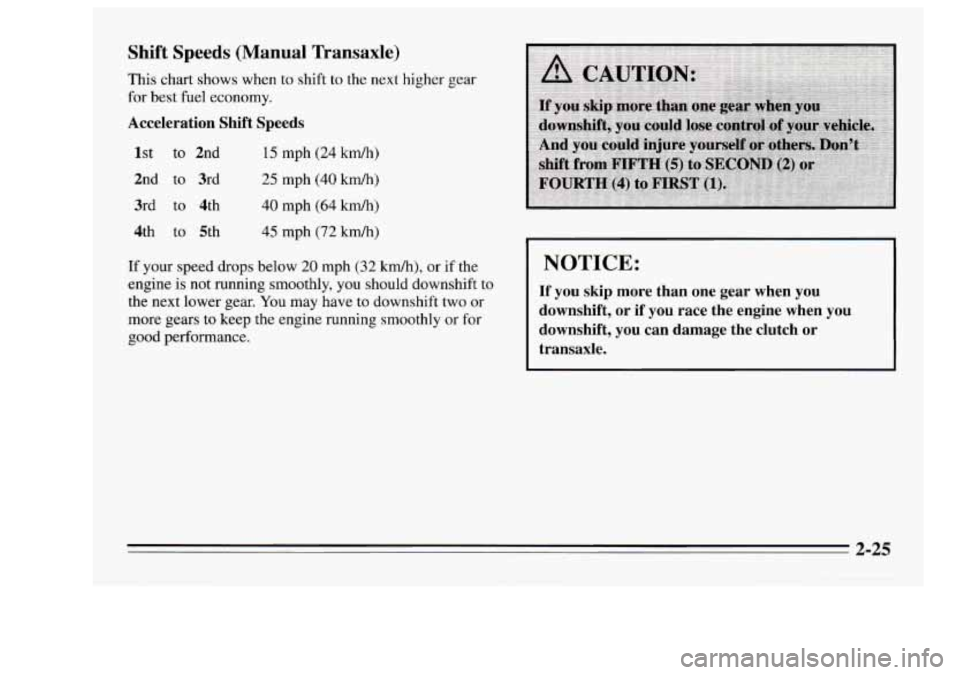
Shift Speeds (Manual Transaxle)
This chart shows when to shift to the next higher gear
for best fuel economy.
Acceleration Shift Speeds
1st to 2nd
2nd to 3rd
3rd to 4th
4th to 5th 15 mph (24 km/h)
25 mph (40 km/h)
40 mph (64 km/h)
45 mph (72 km/h)
If your speed drops below 20 mph (32 km/h), or if the
engine
is not running smoothly, you should downshift to
the next lower gear.
You may have to downshift two or
more gears to keep the engine running smoothly or for
good performance.
I NOTICE:
If you skip more than one gear when you
downshift, or if you race
the engine when you
downshift, you can damage the clutch or
transaxle.
2-25
-
Page 84 of 340

3.
4.
Move the key to LOCK.
Remove the key and take it with you. If you can
walk away
from your vehicle with the key in your
hand, your vehicle is in PARK
(P).
Leaving Your Vehicle With the Engine
Running (Automatic ’Ramaxle Models Only)
If you have to leave your vehicle with the engine
running, be sure your vehicle is in
PARK (P) and your
parking brake is firmly
set before you leave it. After you’ve moved
the shift lever
into the PARK (P)
position, hold the regular brake pedal down. Then, see if
you can move the shift lever away from PARK (P)
without first pushing the button.
If you can, it means that the shift lever wasn’t fully
locked into
PARK (P).
Torque Lock (Automatic Transaxle)
If you are parking on a hill and you don’t shift your
transaxle into
PARK (P) properly, the weight of the
vehicle may put too much force on the parking pawl
in
the transaxle. You may find it diffkult to pull the shift
lever out of PARK
(P). This is called “torque lock.” To
prevent torque lock, set the parking brake and then shift
into PARK (P) properly before you leave the driver’s
seat.
To find out how, see “Shifting Into PARK (P)” in
the Index.
When you
are ready to drive, move the shift lever out of
PARK (P)
before you release the parking brake.
If “torque lock” does occur, you may need to have
another vehicle push yours a little uphill to take some of
the pressure from the transaxle,
so you can pull the shift
lever out of
PARK (P).
2-28
Page 86 of 340
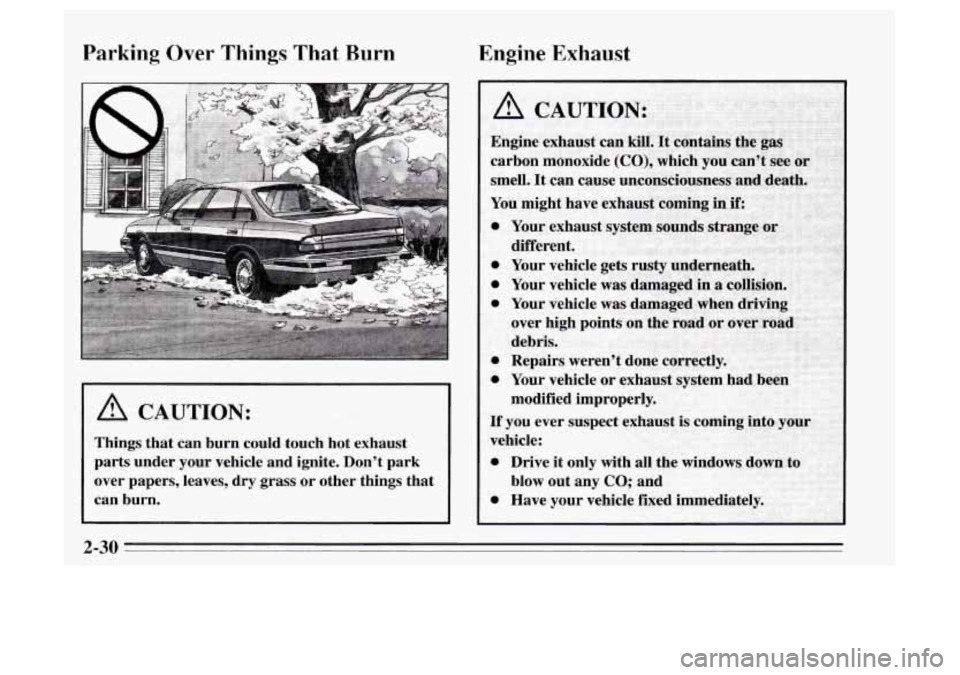
Parking Over Things That Burn Engine Exhaust
A CAUTION:
Things that can burn could touch hot exhaust
parts under your vehicle and ignite. Don’t park
over papers, leaves,
dry grass or other things that
can burn. smell. It can cause unconsciousness and,.death.
: ..:.
Page 87 of 340
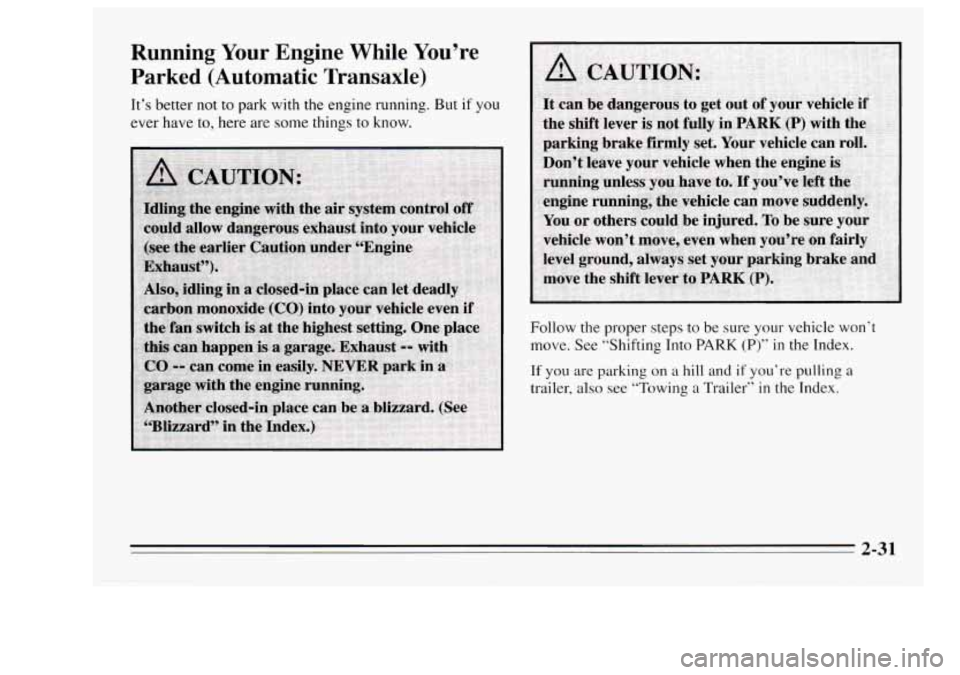
Running Your Engine While You’re
Parked
(Automatic Transaxle)
It’s better not to park with the engine running. But if you
ever have to, here are some things to know.
Follow the proper steps to be sure
your vehicle won’t
move. See “Shifting Into
PARK (P)” in the Index.
If you are parking on a hill and if you’re pulling a
trailer, also see “Towing a Trailer” in the Index.
2-31
. ~~
Page 115 of 340
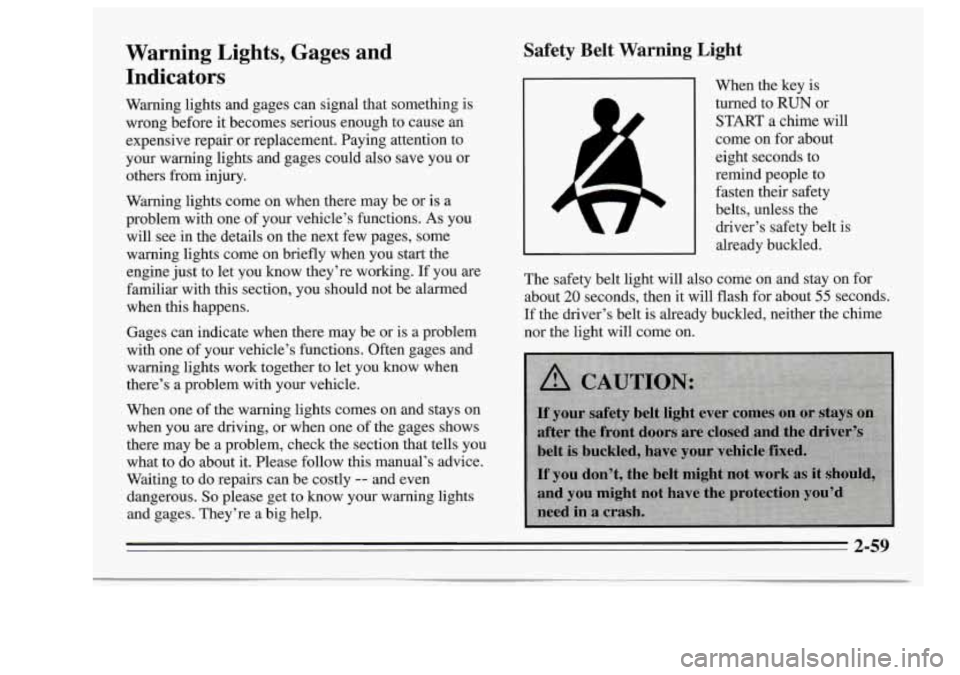
Warning Lights, Gages and
Indicators
Warning lights and gages can signal that something is
wrong before it becomes serious enough to cause an
expensive repair or replacement. Paying attention to
your warning lights and gages could also save you or
others from injury.
Warning lights come on when there may be or is a
problem with one of your vehicle’s functions.
As you
will see
in the details on the next few pages, some
warning lights come on briefly when you start the engine just to let you know they’re working. If you are
familiar with this section, you should not be alarmed when this happens.
Gages can indicate when there may be or is a problem
with one of your vehicle’s functions. Often gages and
warning lights work together to let you know when
there’s a problem with your vehicle.
When one of the warning lights comes on and stays on
when you are driving, or when one of the gages shows
there may be a problem, check the section that tells you
what to do about it. Please follow this manual’s advice.
Waiting to do repairs can be costly
-- and even
dangerous.
So please get to know your warning lights
and gages. They’re a big help.
Safety Belt Warning Light
When the key is
turned to
RUN or
START a chime will
come on for about
eight seconds to
remind people to fasten their safety
belts, unless the
driver’s safety belt
is
already buckled.
The safety belt light will also come on and stay on for
about
20 seconds, then it will flash for about 55 seconds.
If the driver’s belt is already buckled, neither the chime
nor the light will come on.
2-59
Page 116 of 340
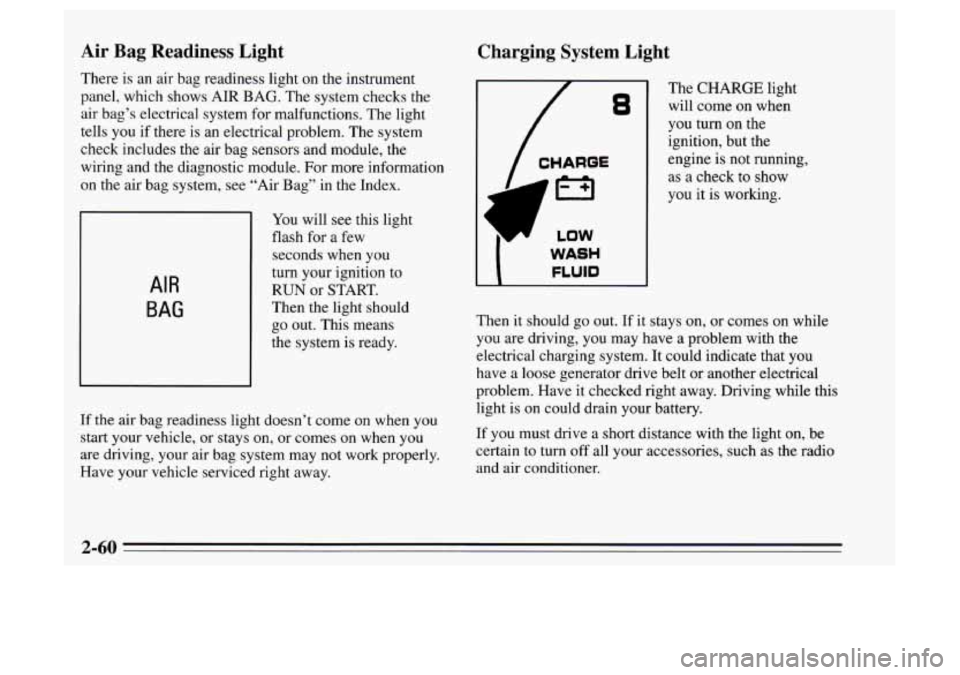
Air Bag Readiness Light
There is an air bag readiness light on the instrument
panel, which shows AIR BAG. The system checks the
air bag’s electrical system for malfunctions. The light
tells
you if there is an electrical problem. The system
check includes the air bag sensors and module, the
wiring and the diagnostic module. For more information
on the air bag system, see “Air Bag” in the Index.
AIR
BAG
You will see this light
flash for a few
seconds when you
turn your ignition to
RUN or START.
Then the light should
go out. This means
the system is ready.
If the air bag readiness light doesn’t come on when you
start your vehicle, or stays on, or comes on when you
are driving, your air bag system may not work properly.
Have your vehicle serviced right away.
Charging System Light
WASH
I FLUID
The CHARGE light
will come on when
you turn on the
ignition, but the
engine is not running,
as a check to show
you it is working.
Then it should go out. If it stays on, or
co !s on while
you are driving, you may have a problem with the
electrical charging system. It could indicate that you
have a loose generator drive belt or another electrical
problem. Have it checked right away. Driving while this
light
is on could drain your battery.
If you must drive
a short distance with the light on, be
certain to turn off all your accessories, such
as the radio
and air conditioner.
2-60
Page 117 of 340
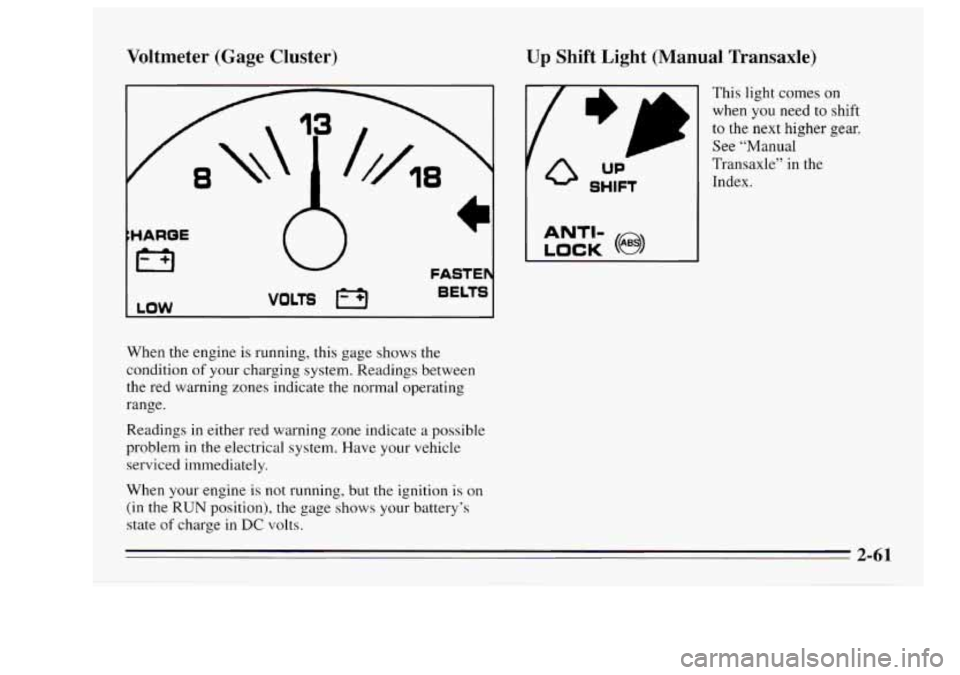
Voltmeter (Gage Cluster)
8
Up Shift Light (Manual Transaxle)
FASTE d
VOLTS 1-J BELTS
LOW
When the engine is running, this gage shows the
condition
of your charging system. Readings between
the red warning zones indicate the normal operating
range.
Readings in either red warning zone indicate
a possible
problem
in the electrical system. Have your vehicle
serviced immediately.
When your engine
is not running, but the ignition is on
(in the RUN position), the gage shows your battery’s
state
of charge in DC volts.
I LOCK (@I
ANTI-
This light comes on
when you need to shift
to the next higher gear.
See “Manual
Transaxle” in the
Index.
2-61
Page 119 of 340
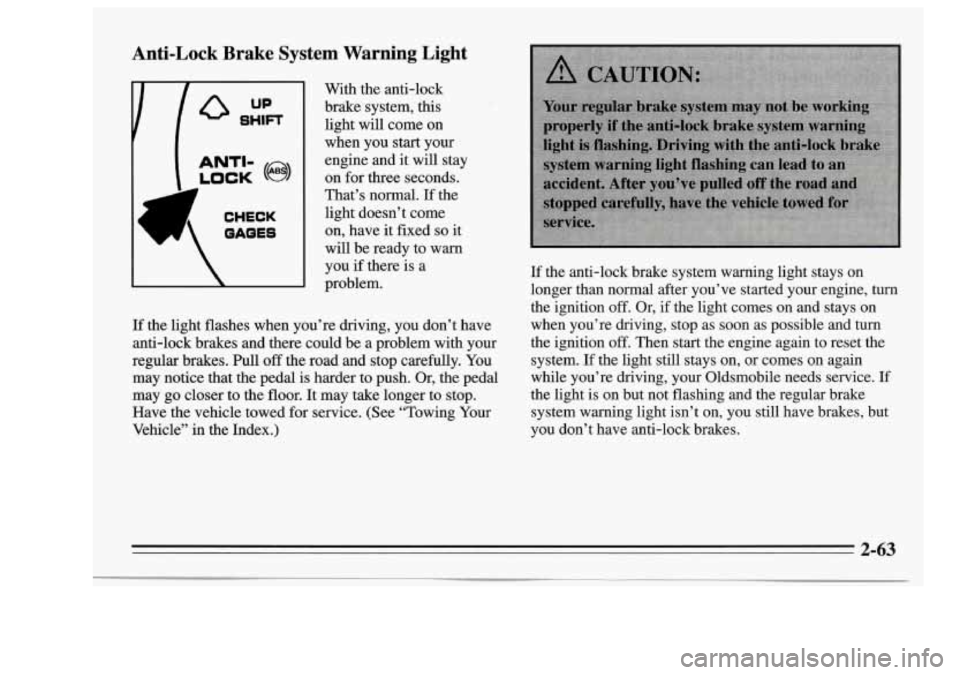
Anti-Lock Brake System Warning Light
‘A CHECK
OAQES
With the anti-lock
brake system,
this
light will come on
when you start your
engine and it will stay
on for
three seconds.
That’s normal.
If the
light doesn’t come
on, have it fiied
so it
will be ready to warn
you
if there is a
problem.
If the light flashes when you’re driving, you don’t have
anti-lock brakes and there could be a problem with your
regular brakes. Pull
off the road and stop carefully. You
may notice that the pedal is harder to push. Or, the pedal
may go closer to the floor. It may take longer to stop.
Have the vehicle towed for service. (See “Towing Your
Vehicle” in the Index.)
If the anti-lock brake system warning light stays on
longer than normal after you’ve started your engine,
turn
the ignition off. Or, if the light comes on and stays on
when you’re driving, stop as soon as possible and turn
the ignition
off. Then start the engine again to reset the
system.
If the light still stays on, or comes on again
while you’re driving, your Oldsmobile needs service.
If
the light is on but not flashing and the regular brake
system warning light isn’t on, you still have brakes, but
you don’t have anti-lock brakes.
2-63
Page 120 of 340
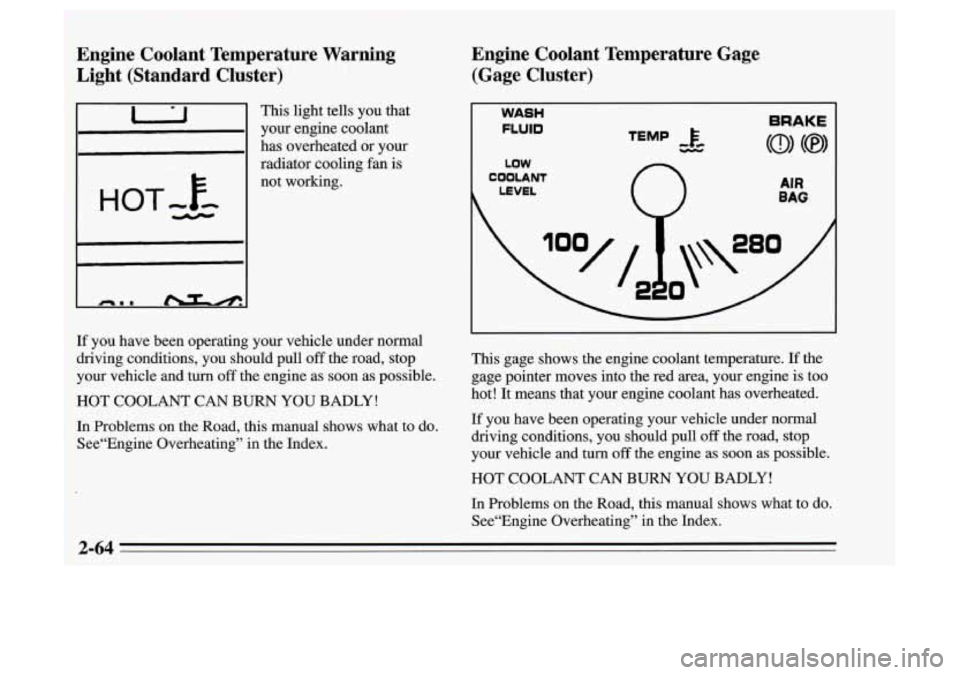
Engine Coolant Temperature Warning
Light (Standard Cluster) Engine Coolant Temperature Gage
(Gage Cluster)
This light tells you that
your engine coolant
has overheated or your
radiator cooling fan
is I
not working.
-
i you have been operating your vehicle under normal
~ driving conditions, you should pull off the road, stop
your vehicle and
turn off the engine as soon as possible.
HOT COOLANT CAN BURN YOU BADLY!
In Problems on the Road, this manual shows what to do.
1 See“Engine Overheating” in the Index.
TEMP
BRAKE WASH
FLUID
HN
LOW
COOLANT
LEVEL AIR
BAG
280
This gage shows the engine coolant temperature. If the
gage pointer moves into the red area, your engine is too
hot! It means that your engine coolant has overheated.
If you have been operating your vehicle under normal
driving conditions, you should pull
off the road, stop
your vehicle and
turn off the engine as soon as possible.
HOT COOLANT CAN BURN YOU BADLY!
In
Problems on the Road, this manual shows what to do.
See“Engine Overheating” in the Index.